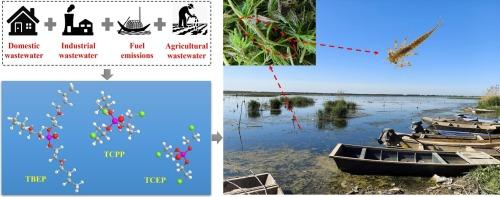豆娘幼虫能否作为评估水生环境中有机磷酯污染的生物指示物种?
IF 7
2区 环境科学与生态学
Q1 ENVIRONMENTAL SCIENCES
引用次数: 0
摘要
豆娘幼虫已被广泛用于淡水生态系统环境质量评价。然而,对豆娘幼虫中有机磷酯的污染特性研究较少。本研究首次对358份豆娘幼虫中OPEs的污染特征、影响因素及生物富集情况进行了研究。结果表明,豆蛉幼虫中OPEs的浓度在20.56 ~ 2363.02 ng/g湿重(ww)之间,超过了以往对其他水生生物的研究。三(2-丁氧乙基)磷酸酯(TBEP)为主要的OPEs,范围为1.56 ~ 2318.94 ng/g (ww),占总OPEs的7.59 ~ 98.13%。豆娘幼虫对TBEP表现出显著的生物富集,富集因子为249,917 L/kg,这可能是由于其对TBEP具有较高的敏感性。然而,辛醇-水分配系数logKow与生物富集系数logbcf之间没有显著的相关性,这表明logKow可能不是影响豆蛉幼虫中OPE化合物生物富集的唯一因素。豆豆蝇幼虫中OPE浓度与水温呈显著正相关,与总氮水平呈显著负相关。造成OPE污染的主要来源是日常活动和船舶交通、工业生产过程和农业实践中的农药应用。这些结果提示豆娘幼虫可以作为评价水体环境中OPE复合污染的生物指标。本文章由计算机程序翻译,如有差异,请以英文原文为准。

Can damselfly larvae serve as bioindicator species for assessing contamination of organophosphate esters in aquatic environments?
Damselfly larvae have been widely used to evaluate the environmental quality of freshwater ecosystems. However, there have been limited studies on the pollution characteristics of organophosphate esters (OPEs) in damselfly larvae. This study investigated the pollution profiles, influencing factors, and biological enrichment of OPEs in a total of 358 damselfly larvae for the first time. The results demonstrated that the concentration of OPEs in the damselfly larvae ranged from 20.56 to 2363.02 ng/g wet weight (ww), exceeding levels reported in previous studies on other aquatic organisms. Tris(2-butoxyethyl) phosphate (TBEP) was identified as the main OPE, ranging from 1.56 to 2318.94 ng/g (ww) and accounting for 7.59–98.13 % of total OPEs detected. Damselfly larvae exhibited significant biological enrichment for TBEP with an enrichment factor of 249,917 L/kg, probably due to their inherent high sensitivity to this pollutant. However, there was no significant correlation between logKow (octanol-water partition coefficient) and log BCF (bioconcentration factor), suggesting that logKow may not be the sole factor affecting biological enrichment of OPE compounds in damselfly larvae. OPE concentrations in damselfly larvae showed a positive correlation with water temperature, whereas a significantly negative correlation with total nitrogen levels. The main sources contributing to OPE pollution were daily activities and ship traffic, industrial production processes, and pesticide applications in agricultural practices. These findings suggest that damselfly larvae can serve as bioindicators for assessing OPE compound contamination in aquatic environments.
求助全文
通过发布文献求助,成功后即可免费获取论文全文。
去求助
来源期刊

Ecological Indicators
环境科学-环境科学
CiteScore
11.80
自引率
8.70%
发文量
1163
审稿时长
78 days
期刊介绍:
The ultimate aim of Ecological Indicators is to integrate the monitoring and assessment of ecological and environmental indicators with management practices. The journal provides a forum for the discussion of the applied scientific development and review of traditional indicator approaches as well as for theoretical, modelling and quantitative applications such as index development. Research into the following areas will be published.
• All aspects of ecological and environmental indicators and indices.
• New indicators, and new approaches and methods for indicator development, testing and use.
• Development and modelling of indices, e.g. application of indicator suites across multiple scales and resources.
• Analysis and research of resource, system- and scale-specific indicators.
• Methods for integration of social and other valuation metrics for the production of scientifically rigorous and politically-relevant assessments using indicator-based monitoring and assessment programs.
• How research indicators can be transformed into direct application for management purposes.
• Broader assessment objectives and methods, e.g. biodiversity, biological integrity, and sustainability, through the use of indicators.
• Resource-specific indicators such as landscape, agroecosystems, forests, wetlands, etc.
 求助内容:
求助内容: 应助结果提醒方式:
应助结果提醒方式:


